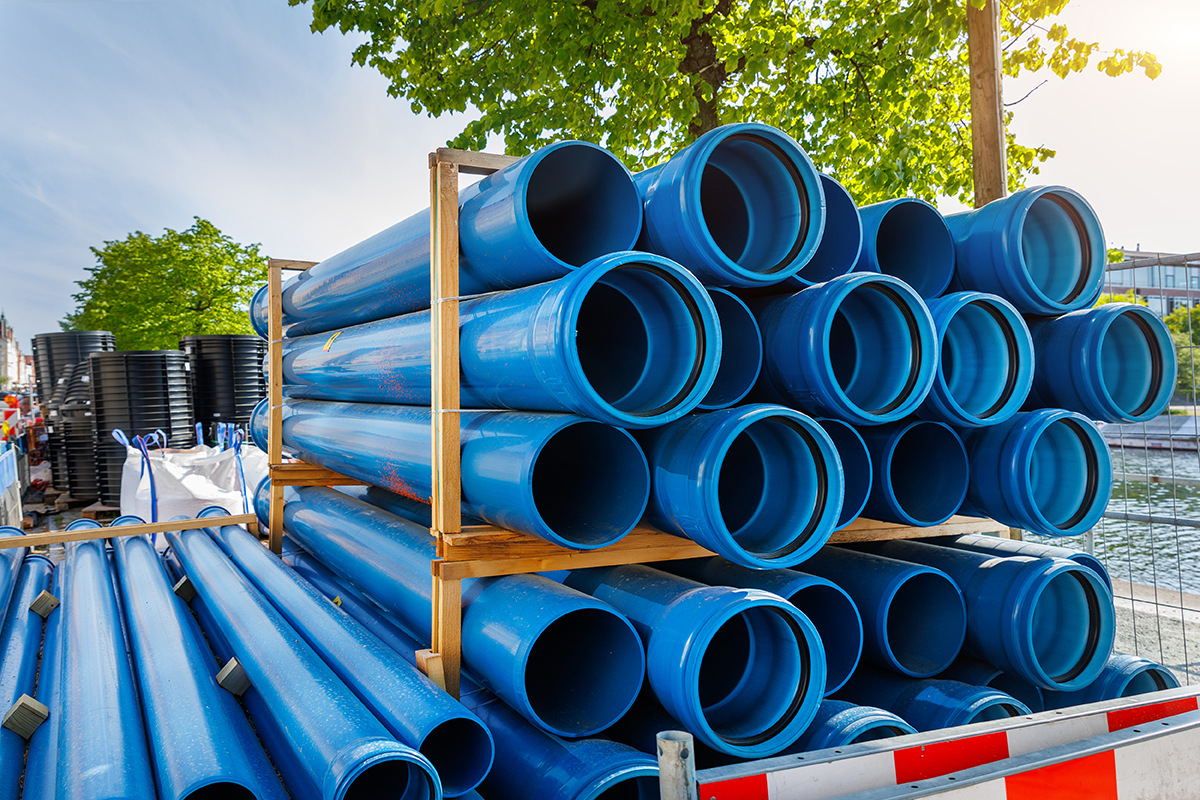Polyethylene (PE) pipe material designation codes have undergone significant changes in recent years. These revisions have primarily affected classifications for materials such as PE 3408 and high-density polyethylene (HDPE) pipe, including specifications like DR17 HDPE, DR9 HDPE, and HDPE pipe schedule 80. The updated codes now provide more detailed information about density, stress crack resistance, and hydrostatic design stress. These changes reflect advancements in material science and aim to improve the selection and application of PE pipes across various industries, ensuring better performance and longevity in modern piping systems.
What are Material Designation Codes?
Material designation codes are standardized identifiers used to classify thermoplastic materials, particularly polyethylene (PE), based on their physical properties and performance characteristics. These codes consist of a two-letter prefix “PE” followed by four digits. The digits convey critical information regarding the material’s density, resistance to slow crack growth, and hydrostatic design stress (HDS) ratings, which are essential for determining the suitability of the material for various applications.
For example, in the code PE 4710:
- P indicates polyethylene.
- The first digit represents the density classification.
- The second digit indicates the stress crack resistance (PENT value).
- The last two digits denote the HDS when tested in water at 73°F (23°C), divided by 100.
This system allows engineers and manufacturers to quickly identify the material’s capabilities and appropriate uses in piping systems.
Key Changes in PE Pipe Material Designation Codes
Recent changes in polyethylene (PE) pipe material designation codes have been driven by revisions to standards set by ASTM and the Plastics Pipe Institute (PPI). These changes reflect advancements in material performance and aim to enhance safety and efficiency, particularly in gas distribution applications. The updates primarily affect the classification and identification of high-density polyethylene (HDPE) materials, including popular variants like PE 3408, DR17 HDPE, DR9 HDPE, and HDPE pipe schedule 80.
Streamlined Material Designations
A major change has been the limitation of PE pipe materials to two primary designations: PE 2708 and PE 4710. This streamlining reflects a focus on high-performance materials that meet stringent safety and performance criteria. Consequently, several older material designation codes have been phased out, including PE 2606, PE 3608, PE 3710, and PE 4608.
This elimination of older codes serves to align the industry with current practices emphasizing higher performance standards, improved resistance to slow crack growth (SCG), and higher hydrostatic design stress (HDS) values.
Enhanced Classification Criteria
The new classification system places a strong emphasis on high-density polyethylene (HDPE) materials. PE 4710, for instance, represents a high-performance material that meets rigorous testing standards, including a minimum PENT (Puncture Resistance) value of 500 hours. This signifies enhanced durability and reliability under stress compared to older materials like PE 3408.
Key aspects of the new classification criteria include a minimum SCG cell class of 7 for materials approved under ASTM D2513, and updated hydrostatic design stress ratings, with PE 4710 achieving up to 1000 psi.
New Marking and Color Requirements
The updated standards have introduced strict regulations regarding pipe markings and colors to enhance safety and prevent misidentification. These include the prohibition of markings indicating uses for potable water, sewer systems, or reclaimed water on gas distribution pipes, and the standardization of color for gas distribution PE pipes to yellow only.
Industry Implications
These changes in PE pipe material designation codes reflect a significant shift towards improved safety and performance standards. By focusing on high-performance materials like PE 2708 and PE 4710, the industry ensures that only the most reliable materials are utilized in critical applications such as gas distribution.
The implications include enhanced safety in gas distribution systems, improved long-term performance of PE piping systems, a simplified material selection process for engineers and contractors, and better alignment with international standards and best practices.
As the industry continues to evolve, these changes in material designation codes serve as a foundation for future advancements in PE pipe technology, ensuring that safety, reliability, and performance remain at the forefront of gas distribution infrastructure.
Impact on ASTM Standards
The changes in PE pipe material designation codes have significant implications for ASTM Standards. ASTM International, formerly known as the American Society for Testing and Materials, plays a crucial role in developing and publishing technical standards for a wide range of materials, including polyethylene pipes.
The new material designations necessitate updates to several key ASTM standards, including ASTM D3350 (Standard Specification for Polyethylene Plastics Pipe and Fittings Materials) and ASTM F714 (Standard Specification for Polyethylene (PE) Plastic Pipe (DR-PR) Based on Outside Diameter). These revisions ensure that the standards align with the latest material classifications and performance criteria. For instance, ASTM D3350 has been updated to include the new cell classification system that reflects the enhanced properties of materials like PE 4710. Similarly, ASTM F714 now incorporates the updated pressure ratings and design factors associated with these high-performance materials.
These changes in ASTM Standards not only reflect the industry’s move towards more advanced PE materials but also provide a framework for consistent quality control and product certification across the industry.
PE 3408 and Its Evolution
PE 3408 has been a widely used material designation for PE pipes. Under the new system, PE 3408 remains in use but with updated specifications. The code breakdown for PE 3408 is as follows:
- 3 – Density: >0.940 – 0.947
- 4 – Slow Crack Growth (PENT): 10 hours
- 08 – Maximum HDS: 800 psi (using a 0.50 design factor)
However, with the introduction of high-performance materials, new codes such as PE 3608, PE 3708, and PE 3710 have emerged. These materials offer improved properties, particularly in terms of slow crack growth resistance and hydrostatic design stress.
For instance, PE 3710 represents a high-performance material with the same density range as PE 3408 but with significantly improved slow crack growth resistance (500 hours PENT) and a higher maximum HDS of 1000 psi (using a 0.63 design factor).
HDPE Pipe Specifications: DR17, DR9, and Schedule 80
High-Density Polyethylene (HDPE) pipes are commonly specified using Dimension Ratio (DR) or schedule ratings. These specifications relate to the pipe’s wall thickness relative to its outer diameter. The following table compares the key characteristics of DR17, DR9, and Schedule 80 HDPE pipes:
| Specification | Wall Thickness | Pressure Rating | Typical Applications |
| DR17 | Outer diameter is 17 times the wall thickness | Moderate | Balance between strength and cost-effectiveness; moderate pressure applications. |
| DR9 | Outer diameter is 9 times the wall thickness | Higher | More demanding applications with higher internal pressures. |
| Schedule 80 | Option offering the thickest walls | Highest | Industrial applications requiring maximum strength and durability. |
The choice between these specifications depends on factors such as operating pressure, installation environment, and specific application requirements. It’s important to consider the material designation code in conjunction with the DR or schedule rating to ensure the selected pipe meets all necessary performance criteria.
Implications of Changes in PE Pipe Material Designation Codes
The recent changes in PE pipe material designation codes have far-reaching implications for various stakeholders in the industry. These modifications affect manufacturers, engineers, and utilities involved in the design and installation of PE piping systems.
Standardization of Performance Expectations
By focusing on two primary material designations (PE 2708 and PE 4710), the industry aims to standardize performance expectations. This simplification allows for more consistent quality and performance across different manufacturers and applications.
Enhanced Safety Measures
The new standards contribute to enhanced safety measures in gas distribution systems. By specifying higher-performance materials and more rigorous testing protocols, the risk of failures and potential hazards is reduced.
Improved Reliability
The transition towards these new standards reflects a broader trend within the industry towards higher-performance materials. These materials can better withstand modern demands, leading to improved overall reliability in gas distribution systems.
Compliance with Regulations
The updated codes ensure compliance with the latest safety regulations. This alignment helps stakeholders meet regulatory requirements more easily and consistently.
Industry-wide Adaptation
As these standards continue to evolve, stakeholders are encouraged to stay informed about updates from ASTM and PPI. Keeping abreast of these changes ensures adherence to best practices in polyethylene piping applications.
Future Developments
The focus on high-performance materials like PE 4710 suggests a continued trend toward more durable and efficient piping solutions. Industry professionals should anticipate further advancements and potential updates to standards in the future.
These implications highlight the importance of understanding and adapting to the new PE pipe material designation codes. By embracing these changes, the industry can achieve higher levels of safety, efficiency, and reliability in PE piping systems.
Coastal Resource Group – Your PE Pipe Solution
At Coastal Resource Group, we offer a comprehensive range of PE pipe solutions. Our inventory includes HDPE pipes in various specifications like DR17, DR9, and schedule 80, along with fittings and related equipment.
Our expertise helps clients navigate material designation codes and select appropriate products. With fast delivery and 24/7 availability, we ensure your projects stay on track.
We provide both quality PE pipe products and technical guidance. For your PE pipe needs and up-to-date industry knowledge, contact us at (281) 549-4132 or visit our website.


